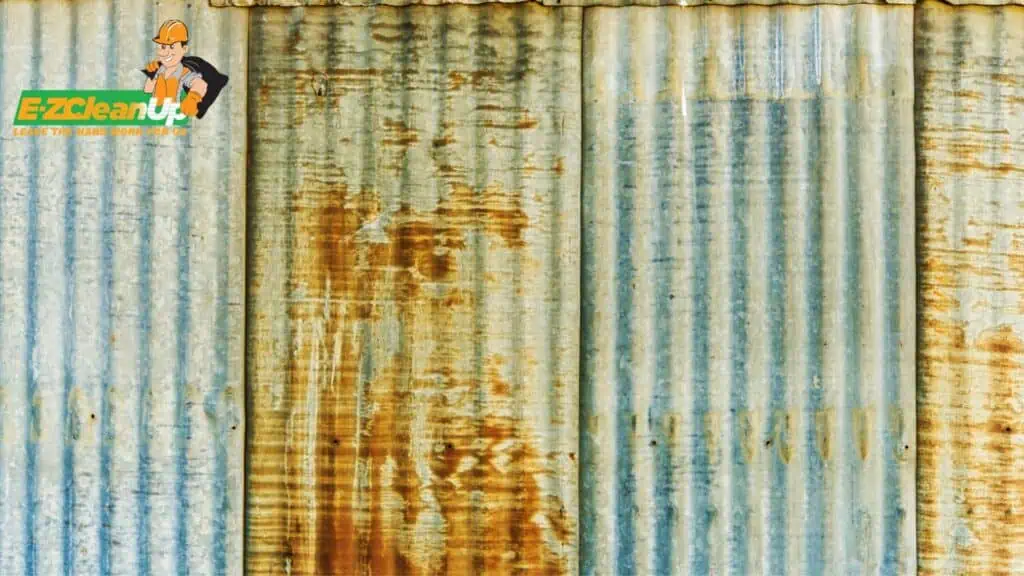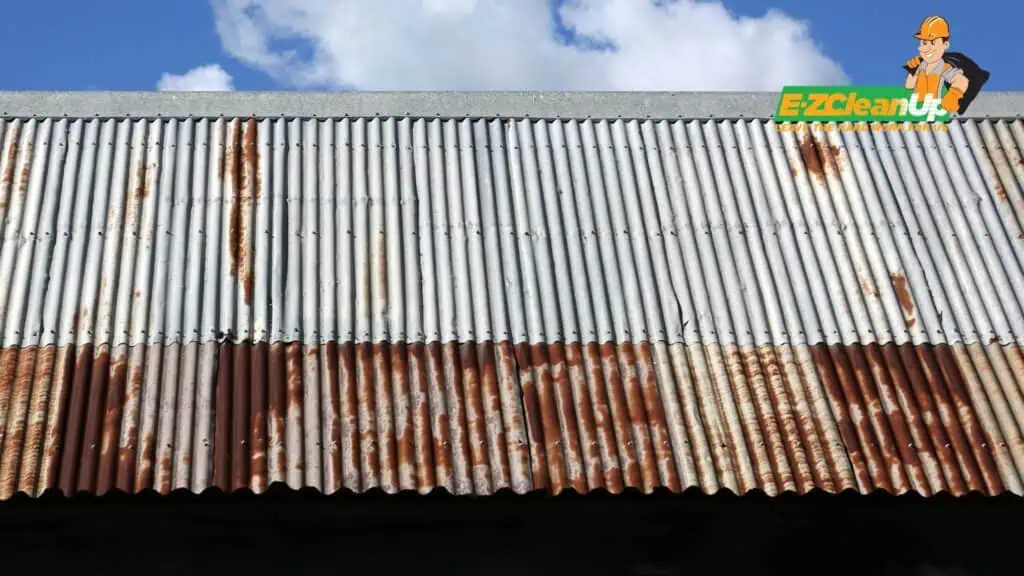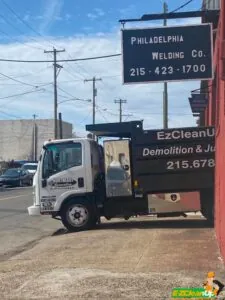Safely dispose of corrugated metal roofing by finding recycling facilities through waste management services or roofing companies. Understand the environmental impact, prep metal sheets, consider professional removal services, and adhere to legal regulations.
Explore more options on how to dispose of corrugated metal roofing safely in our guide below.
Safe Disposal Methods for Corrugated Metal Roofing
Finding the right recycling facility for corrugated metal roofing begins with understanding the high recyclability of metal materials. Steel, for instance, boasts an impressive recycling rate that exceeds 70%.
Meanwhile, other metals like aluminum and copper are similarly sustainable, often reused with high efficiency in terms of energy and resource conservation.
To locate facilities capable of processing corrugated metal roofing, homeowners can start by using the comprehensive search tools provided by major waste management services. For example, websites like Waste Management (WM) and offer user-friendly platforms where you can enter your address to find nearby drop-off locations that accept metal waste.
This search tool is invaluable for quickly identifying local recycling centers that handle metal roofing materials.
Other Resources to Look Into
Specific roofing companies often provide resources to help locate recycling centers or contractors that specialize in metal roofing. You may even find some that offer a locator tool on their website, which allows users to find both distributors and contractors who can manage the disposal and recycling of metal roofing materials.
Understanding the environmental impact of recycling metal roofing is crucial. Metal roof recycling contributes significantly to sustainability efforts by reducing the demand for raw materials.
This is not only beneficial for the environment but can also be economically advantageous due to the value recovered from scrap metal.
For those new to recycling large materials like roofing, it’s important to contact multiple facilities to confirm which types of materials they accept and whether there are any preparation steps required (such as cleaning or dismantling the roofing) before recycling can take place.
Engaging with local recyclers also offers an opportunity to learn more about the recycling process and ensure that your materials are handled responsibly.
Preparing Metal Sheets for Recycling
Preparing corrugated metal sheets for recycling involves a few critical steps to ensure the material is processed efficiently and effectively.
First, it’s important to remove any non-metal components attached to the metal sheets. This includes nails, screws, and any non-metallic fittings or insulation. Clearing these materials helps prevent contamination during the recycling process.
Once the metal is cleared of contaminants, it should be cut into manageable pieces if necessary. This step depends on the facility’s requirements and who you’re planning to send the metal to. Some facilities, such as those working with Instant Roofer, might accept full sheets, while others require the metal to be cut into smaller pieces to fit into recycling machinery.
If you’re planning to replace your old corrugated metal roofing, Instant Roofer can provide a quick and accurate estimate for your new roof installation.
Additionally, sorting the metal by type—separating steel from aluminum, for example—can be a crucial step. This is because different metals are processed in different ways and might even be sent to different recycling facilities. Sorting the metals ensures that each type can be recycled with the highest efficiency and into the highest-quality new products.

Contacting Professional Removal Services
When it comes to large quantities of metal roofing or particularly large sheets that are difficult to handle, professional junk removal services can be invaluable. These services not only help in transporting the heavy and cumbersome materials safely but also ensure that the metal is delivered to the right recycling facilities.
Professional services can be located through local business directories or by contacting local metal roofing suppliers, who often have partnerships with recycling companies and can provide recommendations.
Moreover, some removal services specialize in eco-friendly disposal and will handle the entire process, from dismantling to recycling. Just like us at EZ CleanUp, we ensure that junk disposal helps minimize its environmental impact.
Environmental Benefits of Recycling Corrugated Metal
Recycling corrugated metal significantly conserves natural resources. By reusing metals, we reduce the need for virgin materials such as iron ore, bauxite, and nickel.
Recycling metals prevents the environmentally intensive extraction of raw materials, which involves significant land disruption and energy use. For instance, producing aluminum from recycled materials uses only about 5% of the energy required to produce it from raw ore.
Reducing Landfill Waste
Corrugated metal recycling plays a critical role in reducing landfill waste. Metals have a high recycling rate, with steel and aluminum being among the most recycled materials in the world. In 2018, about 69 million tons of municipal solid waste were recycled in the U.S., with metals making up a significant portion of this.
By diverting metals from landfills, we not only conserve space but also minimize the leaching of metals into groundwater and reduce methane emissions from decomposition processes.

Lowering Energy Consumption
The process of recycling metal is far less energy-intensive than producing new metal from raw materials. Recycling steel, for example, saves 60% to 74% of the energy needed to produce it from raw materials.
For aluminum, the savings are even greater, reducing the energy needed by 90% compared to new production. These energy savings lead to lower carbon emissions. These help combat climate change.
In 2018, recycling and composting of waste saved over 193 million metric tons of carbon dioxide equivalent, which is a significant contribution to mitigating global warming.
Legal Considerations in the Disposal of Metal Roofing
The disposal of metal roofing involves various local regulations, which can significantly differ depending on the state and even the municipality. Most localities adhere to guidelines set forth by state regulations, which in turn align with broader federal mandates to ensure environmental safety and proper waste management.
It’s crucial for contractors and homeowners to consult their local waste management statutes and building codes to understand specific requirements. These local laws might include specifics on how to handle the metal waste, where it can be transported, and what facilities are authorized to accept it.
Compliance with Environmental Regulations
Compliance with environmental regulations, particularly those pertaining to construction and demolition waste, is essential. The EPA and state environmental agencies have clear guidelines that regulate not just the disposal but also the recycling of materials like metal roofing.
For example, if metal roofing contains hazardous materials like asbestos, the Asbestos NESHAP regulations would dictate specific handling and disposal procedures to prevent environmental contamination and health hazards.

Penalties for Improper Disposal
Penalties for non-compliance can include substantial fines and even criminal charges in severe cases. These are imposed not just to punish but to encourage compliance with laws that protect environmental health and public safety.
The fines and the nature of any legal action can vary based on the amount and type of waste improperly disposed of and the environmental impact of the violation. Regular updates and training on current laws, such as those provided by the National Roofing Contractors Association and local environmental agencies, are essential for staying compliant and avoiding these penalties.
Step-by-Step Process for Safe Disposal
Here are the steps you need to take when disposing of corrugated metal roofing:
1. Assess the Condition of the Metal
When preparing to recycle metal roofing, the first step is to conduct a thorough inspection of the materials to check their current state and composition. This involves identifying the type of metal—such as aluminum, copper, steel, or galvanized iron—and examining the roofing for any signs of damage or contamination that could affect recyclability.
2. Identify Metal Types
It’s essential to recognize the specific metals used in your roofing because different metals may require different recycling processes. Common metals used in roofing include galvanized steel and aluminum, which are highly valued in the recycling market due to their recyclability.
3. Check for Contaminants
Ensure that the metal roofing is free from non-metallic contaminants like asphalt, tar, wood, and plastic attachments. These materials must be separated from the metal, as they can interfere with the recycling process.
4. Understand Material Condition
Assess the physical condition of the metal sheets. Look for any severe corrosion or structural damage that might complicate recycling. While most metal roofing materials can be recycled regardless of their condition, knowing the extent of wear can help in determining the most efficient recycling pathway.
5. Learn about Logistics of Recycling
Consider the logistics of transporting the metal to a recycling facility. If the metal roofing is in large, unwieldy panels, it may need to be cut into smaller, manageable pieces for easier handling and transportation.
Sorting Metal Based on Type and Quality
The process starts by using a magnet to distinguish ferrous metals, which are magnetic, from non-ferrous metals, which are not. This simple test helps streamline the sorting process and ensures that each type of metal is processed appropriately for recycling.
Separate Ferrous from Non-Ferrous Metals
Utilize a magnet to identify and separate ferrous metals like steel and iron from non-ferrous metals such as aluminum and copper. Ferrous metals are typically recycled into construction materials, while non-ferrous metals can be used in a wide range of applications due to their resistance to corrosion.

Clean and Prepare the Metals
Remove any contaminants, such as paint, insulation, or fasteners. Clean metals are more valuable as they require less processing before being recycled. For aluminum roofing, ensure that the material is free from dirt and debris to facilitate the recycling process.
Sort by Alloy and Quality
Further categorize the metals by specific alloys and quality grades. Different alloys have different uses and recycling processes, so accurate sorting can maximize the value recovered from the scrap metal.
Alternatives to Disposal: Repurposing Metal Roofing
Repurposing or upcycling old metal roofing offers a sustainable way to enhance your home and garden with unique DIY projects. The durability and aesthetic appeal of metal roofing materials make them ideal for various creative uses:
- Wall Decor and Artistic Pieces: You can cut the metal into various shapes or use it as a canvas for paintings. Creatively painted or naturally weathered pieces can serve as focal points in any room or garden.
- Functional Home Items: Old metal roofing can be upcycled into practical items such as magnetic boards, which are perfect for offices or kitchens. These boards can be painted to match room decor or left in their original metallic finish for a rustic look.
- Outdoor Enhancements: Use metal roofing to craft durable, weather-resistant garden decorations such as trellises or edging for garden beds. These add character to your garden while organizing and separating different plant areas.
- Furniture and Fixtures: Incorporate metal roofing into furniture designs, like tabletops or headboards. The material can also be used to craft unique light fixtures or lampshades.
- Garden and Utility Projects: Construct birdhouses, feeders, or even small shelters using old metal roofing. These projects can enhance the biodiversity of your garden by providing birds with nesting areas and protection from the elements.
Donating to Local Community Projects
Donating old metal roofing to local community projects can significantly contribute to sustainability efforts and community development. One effective way to donate is through organizations like Habitat for Humanity ReStores.
These centers accept a variety of building materials, including metal roofing, which they then sell to fund their housing projects. Donating not only helps divert materials from landfills but also supports affordable housing initiatives.
To donate, locate your nearest Habitat ReStore, check their acceptance criteria, and if possible, take advantage of their pick-up services for large items.

Selling Scrap Metal to Dealers
Selling scrap metal from old roofing can be a practical way to recycle materials while earning some extra cash. Metal roofing is highly valued in the scrap market due to its recyclable nature.
To sell your scrap metal, start by contacting local scrap yards or metal recycling centers to find out their specific requirements and current payout rates. Ensure your metal is clean and sorted by type for the best return. Some facilities might also offer pick-up services for large quantities, making it a convenient option for disposing of substantial metal waste.
Hassle-Free Metal Roofing Disposal with EZ
For many, the disposal of corrugated metal roofing is a source of hassle, filled with regulatory concerns and logistical headaches. EZ CleanUp is here to transform this tedious task into a hassle-free experience.
From handling the initial pickup to ensuring that all materials are recycled in compliance with the highest standards, EZ CleanUp is your go-to expert. Get in touch and let us help you clear your site and recycle responsibly.














